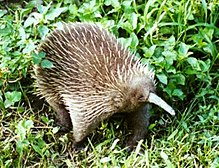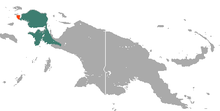346:
407:
92:
218:
395:. The study concludes that the specimen likely was collected in Australia as stated on the label. The researchers argue that the species ought to be recognised in the state's fauna as persisting into the modern era, and could potentially still be extant in poorly surveyed forests of north-western Australia; if locally extinct, reintroduction of this critically endangered species would be worth consideration.
50:
31:
301:, which eats ants and termites, the long-beaked species eats earthworms. The long-beaked echidna is also larger than the short-beaked species, reaching up to 16.5 kilograms (36 lb); the snout is longer and turns downward; and the spines are almost indistinguishable from the long fur. It is distinguished from the other
425:; numbers have decreased due to human activities, including habitat loss and hunting. The western long-beaked echidna is considered a delicacy, and although commercial hunting of the species has been banned by the Indonesian government, traditional hunting is permitted.
376:
It was presumed that the specimen was in fact collected from elsewhere and inadvertently attached to a Tunney collection label. Thus, the specimen received no further attention for many years.
1270:
398:
Burbidge (2017) disputes this conclusion, arguing against each line of evidence, and concluding that the specimen is likely from New Guinea but assigned an incorrect label.
493:
Leary, T.; Seri, L.; Flannery, T.; Wright, D.; Hamilton, S.; Helgen, K.; Singadan, R.; Menzies, J.; Allison, A.; James, R.; Aplin, K.; Salas, L.; Dickman, C. (2016).
1290:
1071:
1136:
383:(2012) examined the specimen and considered various aspects including the circumstantial improbability of a collection label misassignment, the uniqueness of
345:
1229:
1045:
1084:
365:
region of north-west
Australia. However, this species is otherwise thought to be extinct for millennia in Australia; the only other specimens of
1285:
1300:
745:
681:
464:
1305:
1280:
1295:
1275:
354:
1110:
1128:
1089:
362:
54:
406:
1123:
1006:
864:
392:
446:
91:
1141:
738:
387:
found on the specimen, the similarity of some
Kimberley forests to known habitat in New Guinea, an indigenous
318:
1247:
855:
984:
946:
1175:
1011:
418:
349:
Collection label reading "Mt
Anderson", associated with a western long-beaked echidna (click to enlarge)
186:
1032:
993:
823:
814:
731:
588:
411:
298:
217:
930:
838:
517:
163:
39:
562:
712:
326:
322:
230:
86:
1180:
575:
Helgen, Lauren; Kohen, James; Miguez, Roberto
Portela; Helgen, Kristofer M. (28 December 2012).
1076:
1162:
1019:
891:
677:
616:
470:
460:
1167:
786:
704:
651:
606:
596:
512:
1102:
1149:
998:
454:
306:
357:
includes a western long-beaked echidna, with a collection label noting its collection by
305:
species by the number of claws on the fore and hind feet: three (rarely four). It is the
592:
333:, at elevations up to 2,500 metres (8,200 ft). Its preferred habitats are hill and
723:
611:
358:
334:
203:
1264:
1097:
503:
494:
450:
388:
207:
59:
716:
576:
1220:
1024:
442:
384:
282:
261:
361:
in 1901. Curiously, the location of collection is noted as Mount
Anderson, in the
30:
1193:
1115:
1058:
978:
370:
708:
693:(Monotremata, Tachyglossidae), with description of new species and subspecies"
274:
225:
Western long-beaked echidna range (green – extant, orange – possibly extinct)
969:
601:
755:
474:
330:
269:
143:
103:
620:
539:
1154:
635:
1214:
963:
910:
901:
774:
123:
1242:
1234:
1050:
796:
264:
153:
1063:
780:
768:
133:
113:
940:
655:
297:
The western long-beaked echidna is an egg-laying mammal. Unlike the
688:
391:
appearing to depict a long-beaked echidna, and the testimony of an
1188:
405:
344:
76:
70:
456:
Mammal
Species of the World: A Taxonomic and Geographic Reference
422:
1037:
944:
727:
563:
http://rarestzoo.blogspot.com/2006/07/long-beaked-echidna.html
488:
486:
484:
459:(3rd ed.). Johns Hopkins University Press. p. 2.
577:"Twentieth century occurrence of the Long-Beaked Echidna
640:
occur in the
Kimberley region of Western Australia?"
1204:
953:
899:
890:
836:
812:
795:
518:10.2305/IUCN.UK.2016-2.RLTS.T23179A21964204.en
739:
8:
1271:IUCN Red List critically endangered species
941:
896:
809:
746:
732:
724:
216:
48:
29:
20:
610:
600:
516:
369:from Australia are fossils dated to the
434:
1291:Critically endangered fauna of Oceania
581:in the Kimberley region of Australia"
7:
1248:D0B9621F-6C0E-4FE4-992D-5571E14E634A
856:Attenborough's long-beaked echidna (
676:. Australian National History Press
674:Echidnas of Australia and New Guinea
687:Flannery T.F., Groves C.P. (1998).
504:IUCN Red List of Threatened Species
634:Burbidge, Andrew A. (2017-12-21).
14:
355:British Museum of Natural History
90:
672:Augee, M and Gooden, B. 1993.
1:
1286:Mammals of Western New Guinea
874:Western long-beaked echidna (
865:Eastern long-beaked echidna (
1301:Taxa named by Wilhelm Peters
353:The Tring Collection of the
317:The species is found in the
267:and one of three species of
24:Western long-beaked echidna
1306:Taxa named by Giacomo Doria
1281:Endemic fauna of New Guinea
252:western long-beaked echidna
242:(Peters & Doria, 1876)
1324:
709:10.1515/mamm.1998.62.3.367
277:. Originally described as
1296:Mammals described in 1876
927:
763:
689:"A revision of the genus
417:The species is listed as
236:
229:
224:
215:
192:
185:
87:Scientific classification
85:
68:
46:
37:
28:
23:
1276:Monotremes of New Guinea
602:10.3897/zookeys.255.3774
313:Distribution and habitat
307:largest extant monotreme
846:(Long-beaked echidnas)
824:Short-beaked echidna (
453:; Reeder, D.M (eds.).
414:
350:
1206:Tachyglossus bruijnii
1176:Paleobiology Database
511:: e.T23179A21964204.
419:Critically Endangered
409:
348:
279:Tachyglossus bruijnii
260:) is one of the four
55:Critically Endangered
644:Australian Mammalogy
540:"Appendices | CITES"
412:Bogor Zoology Museum
299:short-beaked echidna
16:Species of monotreme
593:2012ZooK..255..103H
447:"Order Monotremata"
323:Bomberai Peninsulas
40:Conservation status
985:Zaglossus bruijnii
955:Zaglossus bruijnii
638:Zaglossus bruijnii
579:Zaglossus bruijnii
497:Zaglossus bruijnii
415:
379:A study by Helgen
351:
341:Kimberley specimen
327:Western New Guinea
257:Zaglossus bruijnii
196:Zaglossus bruijnii
1258:
1257:
1163:Open Tree of Life
999:Zaglossus_bruijni
947:Taxon identifiers
938:
937:
923:
922:
892:Ornithorhynchidae
886:
885:
849:
806:
758:species by family
682:978-0-86840-046-4
466:978-0-8018-8221-0
410:Taxidermy at the
248:
247:
243:
239:Zaglossus bruijni
80:
63:
1313:
1251:
1250:
1238:
1237:
1225:
1224:
1223:
1197:
1196:
1184:
1183:
1171:
1170:
1158:
1157:
1145:
1144:
1132:
1131:
1119:
1118:
1106:
1105:
1093:
1092:
1080:
1079:
1067:
1066:
1054:
1053:
1041:
1040:
1028:
1027:
1015:
1014:
1002:
1001:
989:
988:
987:
974:
973:
972:
942:
897:
858:Z. attenboroughi
848:
847:
843:
810:
805:
804:
800:
787:Australosphenida
748:
741:
734:
725:
720:
660:
659:
631:
625:
624:
614:
604:
587:(255): 103–132.
572:
566:
560:
554:
553:
551:
550:
536:
530:
529:
527:
525:
520:
490:
479:
478:
439:
393:Aboriginal elder
241:
220:
198:
178:Z. bruijnii
95:
94:
74:
57:
52:
51:
33:
21:
1323:
1322:
1316:
1315:
1314:
1312:
1311:
1310:
1261:
1260:
1259:
1254:
1246:
1241:
1233:
1228:
1219:
1218:
1213:
1200:
1192:
1187:
1179:
1174:
1166:
1161:
1153:
1150:Observation.org
1148:
1140:
1135:
1127:
1122:
1114:
1109:
1101:
1096:
1088:
1083:
1075:
1070:
1062:
1057:
1049:
1044:
1036:
1031:
1023:
1018:
1010:
1005:
997:
992:
983:
982:
977:
968:
967:
962:
949:
939:
934:
919:
902:Ornithorhynchus
882:
845:
844:
842:
832:
802:
801:
799:
791:
759:
752:
686:
669:
667:Further reading
664:
663:
656:10.1071/AM17053
633:
632:
628:
574:
573:
569:
561:
557:
548:
546:
538:
537:
533:
523:
521:
492:
491:
482:
467:
441:
440:
436:
431:
404:
343:
335:montane forests
315:
295:
273:that occurs in
211:
200:
194:
181:
89:
81:
64:
53:
49:
42:
17:
12:
11:
5:
1321:
1320:
1317:
1309:
1308:
1303:
1298:
1293:
1288:
1283:
1278:
1273:
1263:
1262:
1256:
1255:
1253:
1252:
1239:
1226:
1210:
1208:
1202:
1201:
1199:
1198:
1185:
1172:
1159:
1146:
1133:
1120:
1107:
1094:
1081:
1068:
1055:
1042:
1029:
1016:
1003:
990:
975:
959:
957:
951:
950:
945:
936:
935:
928:
925:
924:
921:
920:
918:
917:
907:
905:
894:
888:
887:
884:
883:
881:
880:
871:
862:
852:
850:
834:
833:
831:
830:
820:
818:
807:
797:Tachyglossidae
793:
792:
790:
789:
783:
777:
771:
764:
761:
760:
753:
751:
750:
743:
736:
728:
722:
721:
703:(3): 367–396.
684:
668:
665:
662:
661:
650:(2): 315–318.
626:
567:
555:
531:
480:
465:
433:
432:
430:
427:
403:
400:
359:John T. Tunney
342:
339:
314:
311:
294:
291:
281:, this is the
246:
245:
234:
233:
227:
226:
222:
221:
213:
212:
201:
190:
189:
183:
182:
175:
173:
169:
168:
161:
157:
156:
154:Tachyglossidae
151:
147:
146:
141:
137:
136:
131:
127:
126:
121:
117:
116:
111:
107:
106:
101:
97:
96:
83:
82:
69:
66:
65:
47:
44:
43:
38:
35:
34:
26:
25:
15:
13:
10:
9:
6:
4:
3:
2:
1319:
1318:
1307:
1304:
1302:
1299:
1297:
1294:
1292:
1289:
1287:
1284:
1282:
1279:
1277:
1274:
1272:
1269:
1268:
1266:
1249:
1244:
1240:
1236:
1231:
1227:
1222:
1216:
1212:
1211:
1209:
1207:
1203:
1195:
1190:
1186:
1182:
1177:
1173:
1169:
1164:
1160:
1156:
1151:
1147:
1143:
1138:
1134:
1130:
1125:
1121:
1117:
1112:
1108:
1104:
1099:
1095:
1091:
1086:
1082:
1078:
1073:
1069:
1065:
1060:
1056:
1052:
1047:
1043:
1039:
1034:
1030:
1026:
1021:
1017:
1013:
1008:
1004:
1000:
995:
991:
986:
980:
976:
971:
965:
961:
960:
958:
956:
952:
948:
943:
933:
932:
926:
916:
914:
909:
908:
906:
904:
903:
898:
895:
893:
889:
879:
877:
872:
870:
868:
863:
861:
859:
854:
853:
851:
841:
840:
835:
829:
827:
822:
821:
819:
817:
816:
811:
808:
798:
794:
788:
784:
782:
778:
776:
772:
770:
766:
765:
762:
757:
749:
744:
742:
737:
735:
730:
729:
726:
718:
714:
710:
706:
702:
698:
694:
692:
685:
683:
679:
675:
671:
670:
666:
657:
653:
649:
645:
641:
639:
630:
627:
622:
618:
613:
608:
603:
598:
594:
590:
586:
582:
580:
571:
568:
564:
559:
556:
545:
541:
535:
532:
519:
514:
510:
506:
505:
500:
498:
489:
487:
485:
481:
476:
472:
468:
462:
458:
457:
452:
448:
444:
438:
435:
428:
426:
424:
420:
413:
408:
401:
399:
396:
394:
390:
389:cave painting
386:
385:ectoparasites
382:
377:
374:
372:
368:
364:
360:
356:
347:
340:
338:
336:
332:
328:
324:
320:
312:
310:
308:
304:
300:
292:
290:
288:
284:
280:
276:
272:
271:
266:
263:
259:
258:
253:
244:
240:
235:
232:
228:
223:
219:
214:
209:
205:
199:
197:
191:
188:
187:Binomial name
184:
180:
179:
174:
171:
170:
167:
166:
162:
159:
158:
155:
152:
149:
148:
145:
142:
139:
138:
135:
132:
129:
128:
125:
122:
119:
118:
115:
112:
109:
108:
105:
102:
99:
98:
93:
88:
84:
78:
72:
67:
61:
56:
45:
41:
36:
32:
27:
22:
19:
1205:
954:
929:
912:
900:
875:
873:
866:
857:
837:
826:T. aculeatus
825:
815:Tachyglossus
813:
700:
696:
690:
673:
647:
643:
637:
629:
584:
578:
570:
558:
547:. Retrieved
543:
534:
522:. Retrieved
508:
502:
496:
455:
451:Wilson, D.E.
443:Groves, C.P.
437:
416:
402:Conservation
397:
380:
378:
375:
366:
352:
316:
302:
296:
286:
283:type species
278:
268:
256:
255:
251:
249:
238:
237:
195:
193:
177:
176:
164:
18:
1059:iNaturalist
979:Wikispecies
913:O. anatinus
785:(unranked)
756:Monotremata
524:19 November
371:Pleistocene
319:Bird's Head
293:Description
144:Monotremata
73:Appendix II
1265:Categories
1221:Q121812830
911:Platypus (
876:Z. bruijni
867:Z. bartoni
803:(Echidnas)
549:2022-01-14
429:References
275:New Guinea
839:Zaglossus
691:Zaglossus
544:cites.org
367:Zaglossus
363:Kimberley
331:Indonesia
303:Zaglossus
287:Zaglossus
270:Zaglossus
172:Species:
165:Zaglossus
110:Kingdom:
104:Eukaryota
1215:Wikidata
1189:Species+
1129:10300017
1077:10597189
964:Wikidata
931:Category
781:Mammalia
775:Chordata
769:Animalia
767:Kingdom
717:84750399
697:Mammalia
621:23459668
475:62265494
445:(2005).
373:period.
265:echidnas
231:Synonyms
150:Family:
134:Mammalia
124:Chordata
120:Phylum:
114:Animalia
100:Domain:
60:IUCN 3.1
1243:ZooBank
1235:4832724
1116:1000005
1051:2433391
970:Q635949
773:Phylum
754:Extant
612:3560862
589:Bibcode
585:ZooKeys
421:by the
210:, 1876)
160:Genus:
140:Order:
130:Class:
75: (
58: (
1181:233707
1168:565578
1155:201414
1090:552523
1038:323860
779:Class
715:
680:
619:
609:
473:
463:
381:et al.
262:extant
206:&
204:Peters
1142:33543
1103:23179
1072:IRMNG
1064:75237
1025:7GBTL
1012:26198
713:S2CID
636:"Did
449:. In
208:Doria
77:CITES
71:CITES
1230:GBIF
1194:4203
1137:NCBI
1098:IUCN
1085:ITIS
1046:GBIF
1007:BOLD
678:ISBN
617:PMID
565:>
526:2021
509:2016
471:OCLC
461:ISBN
423:IUCN
321:and
250:The
1124:MSW
1111:MDD
1033:EoL
1020:CoL
994:ADW
705:doi
652:doi
607:PMC
597:doi
513:doi
329:of
325:in
285:of
1267::
1245::
1232::
1217::
1191::
1178::
1165::
1152::
1139::
1126::
1113::
1100::
1087::
1074::
1061::
1048::
1035::
1022::
1009::
996::
981::
966::
711:.
701:62
699:.
695:.
648:40
646:.
642:.
615:.
605:.
595:.
583:.
542:.
507:.
501:.
483:^
469:.
337:.
309:.
289:.
915:)
878:)
869:)
860:)
828:)
747:e
740:t
733:v
719:.
707::
658:.
654::
623:.
599::
591::
552:.
528:.
515::
499:"
495:"
477:.
254:(
202:(
79:)
62:)
Text is available under the Creative Commons Attribution-ShareAlike License. Additional terms may apply.

